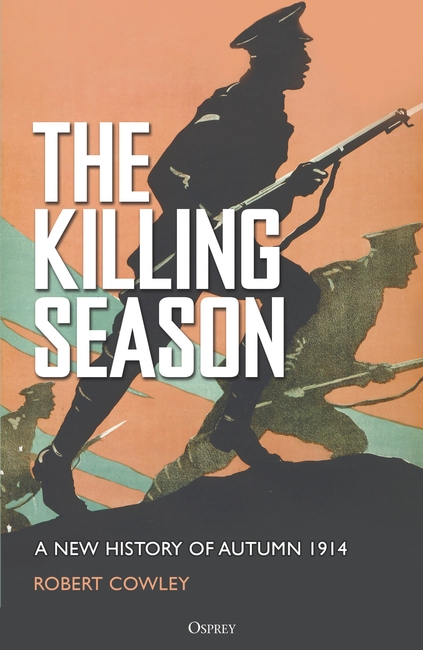
There is good reason for the title of this book, The Killing Season. More men died in the first four months of the Great War on the Western Front than in any comparable interval in the four-year struggle. “The enormous losses in August and September 1914,” writes historian Alan Kramer, “were never equalled at any other time, not even by Verdun.” On a single day, August 22, 1914, the French attained the lethal summit of the war, with 27,000 killed, a figure that exceeded by 8,000 the number of Englishmen killed on a more famous date, July 1, 1916, the first day of the Battle of the Somme.
During the four days of the Battle of the Frontiers, August 20–23, the French had 40,000 killed. (The Germans suffered a mere 15,000 deaths in the same brief interval.) The Great War had been going on for less than three weeks. That August the number of French dead approximated between 75,000 and 84,500. September, the month of the Marne, was worse: 99,000. The corpse fields diminished after that vast battle: 46,000 (October), a still-monstrous 38,300 (November), with a Christmas bonus of only 33,300. By the end of the year, French combat deaths totaled 301,100: roughly one Frenchman killed every forty-three seconds – 2,007 per day.
Let us take the number of Germans killed from the beginning of August to the end of November 1914. The most reliable compilation, undoubtedly, was that reported by the Sänitätsberichte, the German Army Medical Service, early in the 1930s: 18,662 (August); 25,894 (September); 17,720 (October); 14,265 (November) – a total of 76,541 killed in action. In The World Crisis, Winston Churchill raises the figure to 116,750 German Western Front deaths in the same period, a considerable difference. Were the losses of the attacking Germans that much less than those of the French? It seems improbable, but there you are.
The truth is that we will never know to a certainty the ultimate arithmetic of annihilation for both sides. Even today, after more than a century has passed since the end of the Great War, the fields of crosses and headstones, the enclosures and the head-high marble boxes that conceal the prodigal boneheaps of the unidentified, or the thousands of names on memorial walls defy comprehension. Enough time has passed for the statistics of mass grief to turn into metaphor. But whatever estimates of mortality we accept, one circumstance is undeniable: the massacres of autumn produced the earliest chapter in the continuing saga of demographic catastrophe in the twentieth century. We can do no more than speculate on the damage done to our genetic heritage.
“The casualties of the First World War,” writes the late George Steiner, one of our most perceptive public intellectuals, “were not only enormous, they were cruelly selective.” The butcheries that began with the Killing Season “gutted a generation of English moral and intellectual talent, and they eliminated many of the best from the European future.” As the historian Alan Kramer notes, as many as 29.3 percent of those men who entered Oxford between 1905 and 1914 and who served in the military perished, as compared to 12 percent of all men mobilized. Entire pages of magazines like the Tatler or L’Illustration would be thronged with handsome, mustached upper-class faces, those dance cards of the dead. They were the young men who normally would have been groomed to lead and innovate, to administer the colonies that made Europe powerful. In the short term, that would prove a disaster. The voices of division, discord, and revenge, the ham actors of tyranny, the thugocracy of fascism and communism, would before long take center stage.
Why was the rate of killing for those early months of the Western Front so inordinately high? There is a simple answer. Open warfare is far more murderous than fighting from prepared defensive positions. The trenches actually saved lives. During much of that summer and fall, the opponents clashed aboveground in exposed and unprotected country, in one of the most domesticated, but for soldiers dangerously open, landscapes on Earth, amply patterned with fields and well-regulated woodlands, like lethal deer parks that too often offered unobstructed avenues of fire. They did so amid gunfire of all kinds and calibers that continued almost nonstop. Places to hide were scarce.
Artillery, the greatest killer throughout the war, limited only by intermittent shell shortages and tube fatigue of cannon fired too often, thrived in the open. Rifles and machine guns did their share. A single battalion, supposed to number a thousand men but more likely to have been reduced to six or seven hundred, might even fire off a hundred thousand rounds per day – which meant that all up and down the line, millions of bullets were expended every twenty-four hours. In the open, the fraction that collided with flesh may have been small, but was sufficient to kill a few thousand daily.
The killing was only accentuated by the enthusiasm of men going to war for the first time, primed with the bitterness and patriotic misconceptions that governments deliberately ramped up. Nor should we underestimate the effect of the close-order tactics favored early on in the war that, far from overwhelming defenders, more often resulted in close-order slaughters of the attackers. Generals on both sides believed that the defense could best be served by massing troops up front, even in the open. That might have increased firepower, but it also made them ready targets for enemy artillery. The vast numbers of men available asked for vast casualties. Density ruled, but did not always dominate.
Read more in The Killing Season: A New History of Autumn 1914 by Robert Cowley.

Comments
You must be logged in to comment on this post. Click here to log in.
Submit your comment